what to do if 7th goes down but it is leading tone and should go up.
A harmonic pocket-sized calibration
The Solution below shows the A harmonic small scale notes, intervals and scale degrees on the piano, treble clef and bass clef.
The Lesson steps and then explain how to identify the A harmonic pocket-sized scale note interval positions, choose the notation names and scale degree names.
For a quick summary to this topic, accept a look at Harmonic minor scale.
| Key | C | C# | Db | D | D# | Eb | East | E# | Fb | F | F# | Gb | G | Thousand# | Ab | [A] | A# | Bb | B | B# | Cb | All On 1 page |
|---|
Solution - two parts
i. A harmonic pocket-size calibration
This step shows the ascending A harmonic small scale on the piano, treble clef and bass clef. Information technology also shows the calibration degree names for all eight notes.
The A harmonic minor scale has 1 sharp.
This harmonic minor scale is based on the natural modest scale with the aforementioned key / tonic notation - A natural minor calibration.
Since the natural pocket-size central is itself on the Circle of 5ths - A minor on circle of 5ths, this means that this is a ordinarily used harmonic small scale key.
| Note no. | Note interval | Note proper noun |
|---|---|---|
| ane | tonic | The 1st note of the A harmonic minor scale is A |
| two | A-maj-2nd | The 2nd note of the A harmonic minor calibration is B |
| 3 | A-min-3rd | The 3rd note of the A harmonic pocket-sized scale is C |
| four | A-perf-4th | The 4th note of the A harmonic minor scale is D |
| 5 | A-perf-5th | The 5th note of the A harmonic minor scale is E |
| 6 | A-min-6th | The sixth note of the A harmonic minor scale is F |
| 7 | A-maj-7th | The 7th note of the A harmonic minor scale is G# |
| viii | A-perf-8th | The 8th note of the A harmonic pocket-size scale is A |
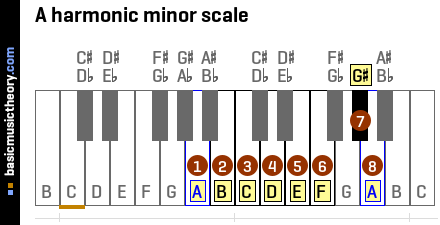
Center C (midi note 60) is shown with an orangish line under the 2d note on the pianoforte diagram.
These note names are shown beneath on the treble clef followed by the bass clef.


The stave diagrams to a higher place prove the scale notes without a key signature, with the sharp / apartment adjustments inserted before each note on the staff.
For the cardinal signature of this scale, showing the symbols grouped correctly side by side to the bass or treble clef symbol at the beginning, take a await at the A harmonic minor key signature.
| Annotation no. | Degree name |
|---|---|
| one | A is the tonic of the A harmonic minor scale |
| ii | B is the supertonic of the A harmonic pocket-size scale |
| 3 | C is the mediant of the A harmonic minor calibration |
| 4 | D is the subdominant of the A harmonic modest calibration |
| 5 | East is the dominant of the A harmonic minor scale |
| half dozen | F is the submediant of the A harmonic pocket-size scale |
| seven | G# is the leading tone of the A harmonic minor calibration |
| 8 | A is the octave of the A harmonic minor scale |
The divergence between the A harmonic small-scale calibration and the A natural pocket-size scale is that the seventh annotation position of the minor scale is raised by one half-tone / semitone.
And then whereas the A natural modest scale has note Thou for the 7th note, this annotation is raised to arrive at annotation K# for this harmonic small calibration.
| | Bass Clef: | Midi | MP3 | | Treble Clef: | Midi | MP3 |
two. A harmonic minor scale descending
This stride shows the descending A harmonic pocket-sized scale on the piano, treble clef and bass clef.
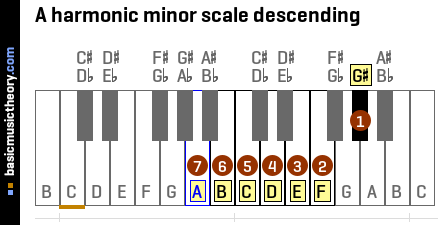
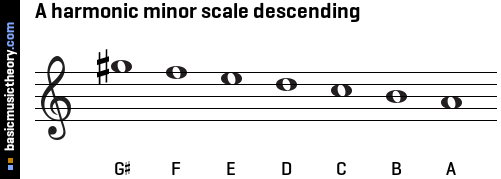
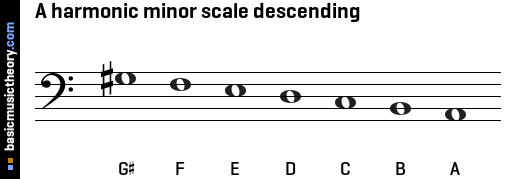
| No. | 1 | two | iii | 4 | five | six | 7 |
|---|---|---|---|---|---|---|---|
| Notation | G# | F | E | D | C | B | A |
| | Bass Clef: | Midi | MP3 | | Treble Clef: | Midi | MP3 |
Lesson steps
one. Piano key note names
This step shows the white and blackness note names on a piano keyboard so that the note names are familiar for later steps, and to testify that the note names kickoff repeating themselves subsequently 12 notes.
The white keys are named using the alphabetic letters A, B, C, D, E, F, and 1000, which is a design that repeats up the piano keyboard.
Every white or black key could accept a apartment(b) or sharp(#) accidental name, depending on how that note is used. In a later on stride, if abrupt or flat notes are used, the exact accidental names volition be chosen.
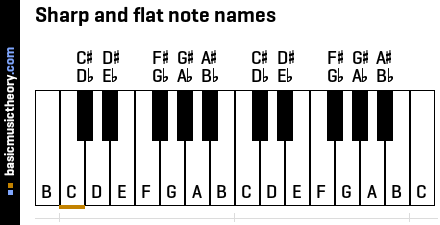
The sound files below play every annotation shown on the piano above, and then middle C (marked with an orange line at the bottom) is the 2nd notation heard.
| | Bass Clef: | Midi | MP3 | | Treble Clef: | Midi | MP3 |
ii. A tonic annotation and ane octave of notes
This step shows an octave of notes in the key of A, to identify the start and end notes of the calibration.
The numbered notes are those that might be used when building this notation calibration.
Just since this is a scale in the cardinal of A, it is certain that notes 1 and 13 will exist used in the scale.
Note one is the tonic note - the starting note - A, and annotation 13 is the same annotation proper name simply one octave higher.
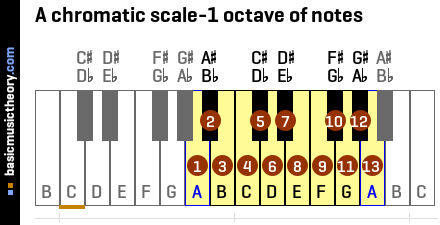
| No. | i | ii | 3 | four | five | half dozen | vii | 8 | 9 | 10 | 11 | 12 | 13 |
|---|---|---|---|---|---|---|---|---|---|---|---|---|---|
| Notation | A | A# / Bb | B | C | C# / Db | D | D# / Eb | E | F | F# / Gb | G | G# / Ab | A |
| | Bass Clef: | Midi | MP3 | | Treble Clef: | Midi | MP3 |
3. A harmonic minor scale note interval positions
This step applies the harmonic pocket-sized scale note interval pattern starting from A, and then that the correct piano keys and note pitches tin can be identified.
The harmonic minor scale uses the W-H-W-W-H-W½-H annotation counting dominion to identify the calibration notation positions.
To count up a Wpigsty tone, count upward past two physical pianoforte keys, either white or black.
To count upward a Half-tone (semitone), count up from the final annotation up by ane physical piano key, either white or black.
To count up a Due west½ tone (whole-tone and a half), count upwardly from the last note past 3 half-tones / semitones - shown equally 3 on the piano below.
The tonic note (shown equally *) is the starting point and is ever the 1st annotation in the harmonic minor scale.
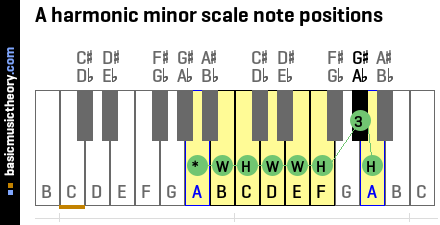
Again, the final 8th note is the octave note, having the aforementioned name equally the tonic note.
| No. | 1 | ii | 3 | 4 | 5 | 6 | 7 | 8 |
|---|---|---|---|---|---|---|---|---|
| Note | A | B | C | D | East | F | Chiliad# / Ab | A |
What is the difference between the A harmonic minor scale and the A natural pocket-sized scale ?
The 7th notation position (or scale caste) of the minor calibration is raised by one half-tone / semitone to arrive at the harmonic minor scale annotation positions shown above, leaving a noticeably big interval of three one-half-tones / semitones between the 6th and 7th note positions for this scale.
| | Bass Clef: | Midi | MP3 | | Treble Clef: | Midi | MP3 |
4. A harmonic minor calibration notes
This step tries to assign annotation names to the piano keys identified in the previous step, so that they tin can be written on a notation staff in the Solution section.
The vii unique notes in a calibration need to be named such that each alphabetic character from A to G is used once simply, so each notation name is either a natural white proper name(A.. Grand) , a precipitous(eg. F#) or a flat(eg. Gb).
This is needed to ensure that when information technology comes to writing the scale notes on a musical staff (eg. a treble clef), there is no possibility of having 2 G-type notes, for example, with ane of the notes needing an accidental next to it on the staff (a abrupt, flat or natural symbol).
To employ this dominion, firstly list the white key names starting from the tonic, which are shown the White column below.
Then list the 7 notes in the scale then far, shown in the next cavalcade.
For each of the 7 notes, await across and try to find the White note name in the Calibration note name.
If the natural white note tin can be found in the scale note, the scale annotation is written in the Match? column.
The eighth note - the octave note, will have the aforementioned name as the first notation, the tonic notation.
| No. | White | Scale annotation | Match? |
|---|---|---|---|
| one | A | A | A |
| 2 | B | B | B |
| 3 | C | C | C |
| 4 | D | D | D |
| 5 | E | E | East |
| half-dozen | F | F | F |
| seven | G | 1000# / Ab | G# |
| eight | A | A | A |
For this harmonic pocket-sized calibration, all notes accept a match, and and so the Match? column shows the harmonic minor calibration note names.

five. A harmonic modest scale descending
This stride shows the notes when descending the A harmonic minor scale, going from the highest note sound back to the starting note.
For harmonic pocket-size scales, the notes names when descending are but the opposite of the ascending names.
So bold octave note eight has been played in the step above, the notes now descend dorsum to the tonic.

| No. | one | ii | 3 | iv | 5 | six | 7 |
|---|---|---|---|---|---|---|---|
| Note | G# | F | East | D | C | B | A |
| | Bass Clef: | Midi | MP3 | | Treble Clef: | Midi | MP3 |
six. A harmonic minor calibration degrees
This step shows the A harmonic modest calibration degrees - tonic, supertonic, mediant, subdominant, dominant, submediant, leading note / tone, and octave.
In music theory, each note in this scale has what is called a scale caste proper name, which describes the relationship of that note to the tonic(1st) note.
Calibration degree names 1,2,3,four,five,half dozen, and viii below are always the same for all major and minor scales (ie. 1st note is always tonic, 2d is supertonic etc.) , just obviously the note names volition exist dissimilar for each scale / cardinal combination.
In the harmonic minor scale, the 7th note is chosen the leading note or leading tone because the sound of the 7th note feels like information technology wants to resolve and finish at the octave note, when all scale notes are played in sequence.
Information technology does this because in this scale, the 7th note is only one half-tone / semitone away from the eighth annotation - the octave notation. The A major calibration and A melodic minor scale scales share the aforementioned property - they both have only ane half-tone / semitone between the 7th and 8th notes.
In contrast, the A natural minor scale has a whole tone (ii half-tones / semitones, two notes on the piano keyboard) betwixt the 7th and 8th notes, and the 7th note does non lean towards the 8th note in the same style. In this case, the 7th notation is called the subtonic.
| Annotation no. | Caste name |
|---|---|
| 1 | A is the tonic of the A harmonic minor scale |
| two | B is the supertonic of the A harmonic pocket-size calibration |
| 3 | C is the mediant of the A harmonic minor scale |
| 4 | D is the subdominant of the A harmonic small calibration |
| 5 | E is the dominant of the A harmonic minor scale |
| 6 | F is the submediant of the A harmonic modest scale |
| vii | G# is the leading tone of the A harmonic minor calibration |
| 8 | A is the octave of the A harmonic minor scale |
| Key | C | C# | Db | D | D# | Eb | E | Eastward# | Fb | F | F# | Gb | G | G# | Ab | [A] | A# | Bb | B | B# | Cb | All On ane folio |
|---|
| Related links | A harmonic pocket-size scale, A, A harmonic small key signature |
|---|---|
| More than minor scales | A natural pocket-sized calibration, A melodic pocket-sized calibration |
| Other scales | A major scale, A chromatic calibration, A major pentatonic scale, A blues scale |
| Intervals | A-1st, A-2nd, A-3rd, A-4th, A-fifth, A-6th, A-7th, A-8th |
| Circle of 5ths | Learn the circle of fifths, A minor on circle of 5ths |
| Modes | A ionian, A dorian, A phrygian, A lydian, A mixolydian, aeolian, A locrian |
| Triad chords | A diminished, A modest, A major, A augmented, A suspended second, A suspended fourth |
| 6th chords | A minor sixth, A major 6th |
| 7th chords | A dim vii, A half-dim7, A min 7, A min-maj 7, A dom 7, A maj 7, A aug seven, A aug-maj 7, A maj vii sus2, A dom 7 sus4, A maj 7 sus4 |
| Scale triad chords | A major triad chords, A small-scale triad chords, A harmonic minor chords, A melodic modest chords |
| Scale 7th chords | A major 7th chords, A minor seventh chords, A harmonic minor 7th chords, A melodic minor 7th chords |
| Triad modes | A ionian, A dorian, A phrygian, A lydian, A mixolydian, aeolian, A locrian |
| 7th modes | A ionian, A dorian, A phrygian, A lydian, A mixolydian, aeolian, A locrian |
| Cadences | A major perfect accurate, A major imperfect accurate, A major plagal, A major one-half, A major deceptive |
holstonsoollike80.blogspot.com
Source: https://www.basicmusictheory.com/a-harmonic-minor-scale
0 Response to "what to do if 7th goes down but it is leading tone and should go up."
Postar um comentário